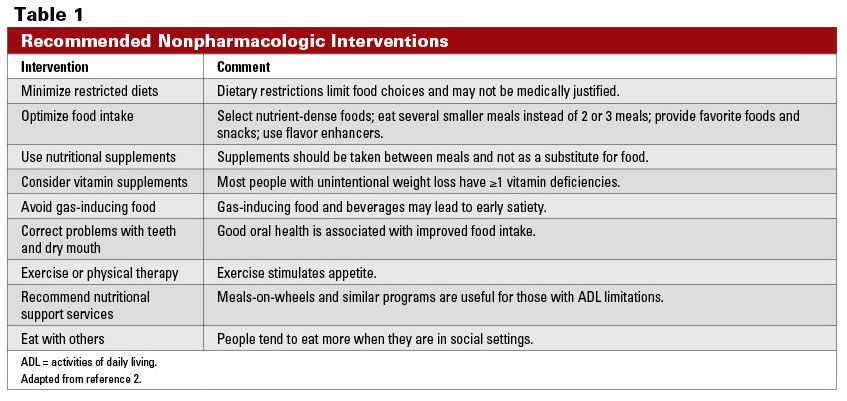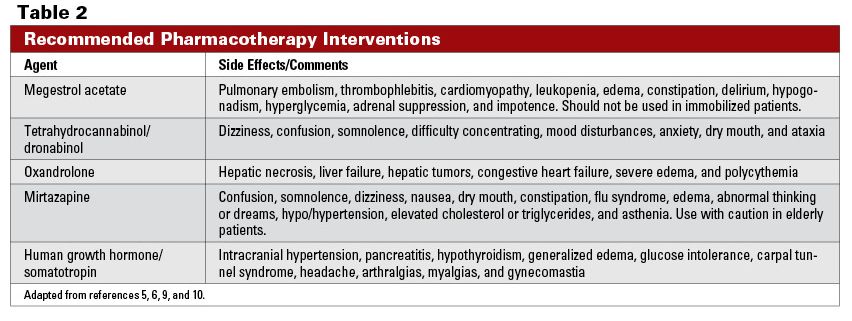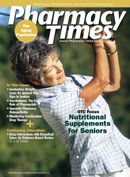Publication
Article
Pharmacy Times
Involuntary Weight Loss - An Ignored Vital Sign in Seniors
Author(s):
Older Americans are disproportionately affected by involuntary wight loss, and assessing it should be as routine as monitoring other vital signs.
Dr. Zanni is a psychologist and health-systems consultant based in Alexandria, Virginia.
Unintentional weight loss often signals serious pathology. Estimates suggest 13.3% of the population experiences unintentional weight loss, and up to 7% experiences a loss exceeding 5% of baseline weight.1 Elders are disproportionately impacted; 27% of frail elders over the age of 65 experience involuntary weight loss.2
Most practitioners and researchers define unintentional weight loss as a 5% to 10% decrease in body weight over a period of 1 to 12 months.3-6 A clinically useful benchmark is 5% over a 6-month period. In 25% of cases, etiology is idiopathic and unknown.7 Identified etiologies generally include:
• Organic. Cancer is the leading cause, accounting for 24% to 38% of cases (weight loss may be the only symptom of tumor burden).5 Dementia results in marked taste and smell alterations, decreasing food’s desirability. Dysphasia often accompanies severe dementia, as do centrally mediated deficits in appetite control and satiety. Other organic causes may be gastrointestinal ([GI]; nausea, vomiting, early satiety, diarrhea), endocrine (hyperthyroidism, uncontrolled diabetes), Parkinson’s disease, and chronic illness (chronic obstructive pulmonary disease, congestive heart failure).4,5
• Psychiatric. Weight loss is depression’s key symptom and may be present with bipolar, personality, dysmorphic, and anxiety disorders, as well as substance abuse and alcoholism, and nicotine addiction. 5
• Functional. Decreased daily living skills and poverty negatively impact shopping and cooking. Poorly fitting, or lack of, dentures makes eating difficult. Caregiver neglect is another factor; the quality of the relationship between the person being fed and the feeder is a predictor of food intake.4 Loneliness and social isolation also are linked to decreased food intake.
• Medication. Medication side effects (anorexia, xerostomia, dysgeusia, dysosmia, dysphagia, nausea, vomiting, and diarrhea) are major causes for weight loss among elders.8
Involuntary weight loss is a predictor of mortality. Studies report that 9% to 38% of people die within 1 to 2½ years following weight loss.1,2 Increased hospitalizations, in-hospital complications, increased risk for institutionalization, increased comorbidities, delayed recovery from injury, delayed wound healing, increased falls, decreased functional abilities, and an overall poorer quality of life are consequences of involuntary weight loss.2,3,8 Mortality is 4 times higher for those with a 5% weight loss within 1 month.6
Normal Age-Related Weight Loss
Lean body mass declines at a rate of 0.3 kg/year (0.66 lb) beginning around the third decade of life. Because lean body mass tends to be replaced by fat, total body weight generally remains stable. Beginning around age 65 to 70, weight loss occurs at a rate of 0.1 to 0.2 kg/year as a result of changes in hormones regulating appetite and satiety, along with decreases in basal metabolic rates.6,8
Assessments
Assessment should establish the cause, and, if reversible, treat accordingly. When patients state their weight loss is the result of dieting, probe for lifestyle changes. Maintaining weight loss is difficult, and if the patient is keeping the pounds off easily, dieting may be a coincidental occurrence.
Patient evaluation follows a 3-step approach, focusing on malignancies, nonmalignant GI disorders, and depression.
Step 1. A comprehensive medical examination is required, along with a medication regimen review and depression screening. Core laboratory tests are conducted, including an ultrasensitive thyroid-stimulating hormone test, urinalysis, and a fecal occult blood test.
Step 2. Computed tomography imaging from neck to pelvis with contrast (and a mammogram for women) should be ordered, especially if step 1 findings are unremarkable.
Step 3. A GI endoscopy, esophagogastroduodenoscopy, or colonoscopy is conducted. These diagnostics have a high yield for a select group of patients.5,6
A differential diagnosis can be difficult, but diagnostics must be justified. A shotgun approach is rarely productive.
Counseling Guidelines
Patients may deny or not report weight loss, so look for clues suggesting it, such as loose-fitting clothing or oversized rings. Probe for oral health problems and GI symptoms (gas, nausea, or vomiting). Determine if weight loss is intentional. Review the patient’s medications to ascertain if they might be contributing factors, and if so, contact the prescribing physician. Patients reporting no change in food intake should see their primary care physician. All patients should be encouraged to use the interventions highlighted in Table 1.


Treatment
Treatment focuses on underlying etiology. Depression and nonmalignant GI diseases are common reversible causes.8 Interventions used to reverse or minimize further weight loss include nonpharmacologic (Table 1) and pharmacologic (Table 2), the former being first-line. Follow-up weekly weight checks are recommended.
No drugs are approved by the FDA for involuntary weight loss. Existing data supporting pharmacologic agents come mostly from small studies. Pharmacologic management results in short-term weight gain (approximately 3-7 lb)11 but does not improve long-term health and mortality. Side effects from orexigenic (appetite-stimulating) and anabolic medications limit their use. Cyproheptadine and dronabinol may promote weight gain; central nervous system toxicity is a concern. Patients receiving megestrol and dronabinol usually gain weight, but weight is primarily adipose tissue, not lean body mass.12 Human growth hormone and other anabolic agents promote weight gain but are associated with increased mortality. Anticytokine therapies, antileptin therapies, and anti-inflammatory medications are under investigation.9 â–

References
1. Sahyoun NR, Serdula MK, Galuska DA, Zhang XL, Pamuk ER. The epidemiology of recent involuntary weight loss in the United States population. J Nutr Health Aging. 2004;8(6):510-517.
2. Alibhai SM, Greenwood C, Payette H. An approach to the management of unintentional weight loss in elderly people. CMAJ. 2005;172(6):773-780.
3. Wallace JI, Schwartz RS. Epidemiology of weight loss in humans with special
reference to wasting in the elderly. Int J Cardiol. 2002;85(1):15-21.
4. Korc B. Addressing involuntary weight loss. American Medical News. February 16, 2009. www.ama-assn.org/amednews/2009/02/16/hlca0216.htm. Accessed December 22, 2009.
5. Graham M, Knight B. The many causes of involuntary weight loss: a 3-step approach to the diagnosis. www.hcplive.com/general/publications/Resident-and-Staff/2006/2006-11/2006-11_04. December 22, 2009.
6. Huffman GB. Evaluating and treating unintentional weight loss in the elderly.
Am Fam Physician
. 2002;65(4):640-650.
7. Thompson MP, Morris LK. Unexplained weight loss in the ambulatory elderly. J
Am Geriatr Soc
.1991;39(5):497-500.
8. Moriguti JC, Moriguti EK, Ferriolli E, et al. Involuntary weight loss in elderly individuals: assessment and treatment. Sao Paulo Med J. 2001;119(2):72-77.
9. Zanni GR. Wasting away: the dangers of unintentional weight loss. Pharmacy Times. 2008;74(6):H8.
10. Smith K, Greenwood C, Payette H, Alibhai S. An approach to the diagnosis of unintentional weight loss in older adults, part one: prevalence rates and screening. Geriatrics & Aging. 2006;9(10):679-685.
11. Smith K, Greenwood C, Payette H, Alibhai S. An approach to the nonpharmacologic and pharmacologic management of unintentional weight loss among older adults. Geriatrics & Aging. 2007;10(2):91-98.
12. Involuntary weight loss: the forgotten vital sign. J Support Oncol. 2003;1(2):142.







